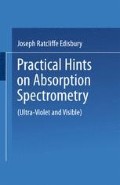Abstract
In routine spectrometry by photoelectric response there is no call for the old type of arc or spark line sources except as standards of wavelength, to be used solely for purposes of calibration. A strong continuous emission spectrum with as little as possible variation along its length, and as small as possible fluctuations in intensity with time, simplifies both design and operation. Existing commercial sources are therefore contrived to achieve these ends.
Many hands don’t always make the light work
Truthful Version
Access this chapter
Tax calculation will be finalised at checkout
Purchases are for personal use only
Preview
Unable to display preview. Download preview PDF.
Rights and permissions
Copyright information
© 1966 Springer Science+Business Media New York
About this chapter
Cite this chapter
Edisbury, J.R. (1966). Light Sources. In: Practical Hints on Absorption Spectrometry. Springer, Boston, MA. https://doi.org/10.1007/978-1-4899-6401-4_7
Download citation
DOI: https://doi.org/10.1007/978-1-4899-6401-4_7
Publisher Name: Springer, Boston, MA
Print ISBN: 978-1-4899-6198-3
Online ISBN: 978-1-4899-6401-4
eBook Packages: Springer Book Archive

